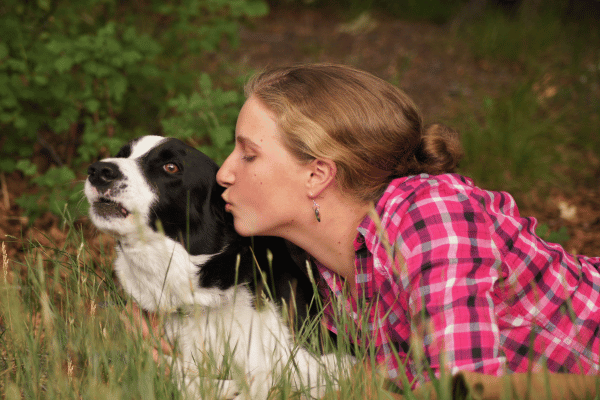Navigating your dog’s adolescence is crucial for a harmonious life together. This stage is filled with challenges and learning opportunities. Understanding and patience are key as you guide your furry friend through this transitional period, ensuring they emerge well-behaved and sociable.
Effective Training During Dog Adolescence

Adolescence in dogs brings unique challenges. Suddenly, your obedient puppy may start testing boundaries, much like a teenager. This phase requires extra patience and consistency in training. It’s essential to reinforce commands and establish clear rules. Positive reinforcement, such as treats and praise, proves effective. Remember, this is a phase; with the right approach, your dog will navigate through it successfully, strengthening your bond.
Behavioral issues often surface during adolescence. You might notice increased stubbornness or selective hearing. Address these behaviors by maintaining a firm yet gentle training regimen. Incorporate daily training sessions focusing on basic commands and social behavior. Consistency is crucial; mixed signals can confuse your dog. Utilize this time to reinforce good habits, ensuring they carry into adulthood. Patience and understanding during this stage are paramount.
Socialization is also critical at this stage. Expose your adolescent dog to various situations, animals, and people to boost their confidence and adaptability. Controlled social settings can help mitigate aggression and fearfulness. Regular walks, dog park visits, and playdates encourage positive interactions. Remember, every dog is unique; tailor your approach to fit your dog’s personality and needs. This personalized attention fosters a well-rounded and sociable adult dog.
Managing Common Behavioral Issues in Adolescence
During adolescence, dogs often exhibit behaviors like excessive barking or chewing. This can be a sign of pent-up energy or anxiety. To manage these issues, ensure your dog gets plenty of physical and mental exercise. Activities like long walks, puzzle toys, and agility training can help channel their energy positively. Remember, understanding the root cause of these behaviors is crucial for effective management and ensuring a peaceful coexistence.
Another common challenge is leash pulling. This behavior not only makes walks less enjoyable but can also be dangerous. Training your dog to walk nicely on a leash involves consistent practice and positive reinforcement. Use treats and praise to reward calm, collected walking. If necessary, consider a training collar or harness that discourages pulling without causing discomfort. Over time, your dog will learn that walking calmly leads to rewards.
Adolescent dogs might also start ignoring previously learned commands, testing their independence. This can be frustrating but is a normal part of their development. Reinforce training through short, focused sessions, using high-value rewards for compliance. Avoid repeating commands without enforcing them, as this can teach your dog they don’t need to listen the first time. Patience and consistency are key to navigating this challenging but rewarding stage of your dog’s life.
Navigating Your Dog’s Adolescence with Patience
Adolescence is a critical time for reinforcing discipline without dampening your dog’s spirit. Implementing structured playtimes and training sessions can significantly aid in managing their boundless energy. Engage in activities that stimulate both their mind and body, ensuring they remain engaged and less prone to mischief. This balanced approach helps in maintaining a happy, healthy relationship between you and your dog, making the adolescence journey smoother for both.
The importance of consistency cannot be overstated during this phase. Adolescent dogs are quick to pick up on inconsistencies in commands and behavior expectations. Establish a routine that includes regular training, exercise, and rest periods. This structure provides them with a sense of security and helps in reinforcing desired behaviors. Remember, every interaction with your dog is an opportunity for training and strengthening your bond.
Lastly, remember that adolescence is just a phase. With the right approach, it can be a period of growth and learning for both you and your dog. Stay patient, keep training sessions positive and rewarding, and don’t hesitate to seek professional help if needed. A certified dog trainer or behaviorist can offer valuable insights and strategies tailored to your dog’s specific needs, ensuring a smooth transition into adulthood.
Enhancing Communication with Your Adolescent Dog

Effective communication is pivotal during your dog’s adolescence. This stage is an excellent time to refine your understanding of dog body language and cues. Paying close attention to these signals enhances your ability to respond appropriately to your dog’s needs and emotions. This mutual understanding fosters a deeper bond and facilitates easier training. Remember, dogs communicate much through body language, so being attuned to these cues is essential.
Incorporate training techniques that encourage your dog to think and solve problems. Activities like hide-and-seek with treats or toys not only stimulate their mind but also teach them to pay attention to your cues. This type of training reinforces your role as the leader and deepens their trust in you. It’s a fun way to keep them mentally engaged and strengthens the communication between you and your adolescent dog.
Lastly, ensure that your training methods are consistent and clear. Dogs thrive on routine and clear expectations. If multiple family members are involved in training, it’s crucial that everyone uses the same commands and rewards system. This consistency helps prevent confusion and reinforces the desired behaviors more quickly. Adolescent dogs are especially sensitive to mixed signals, so a unified approach in training and communication is key to their development.
Building Confidence in Your Adolescent Dog
Confidence building is crucial for adolescent dogs. This can be achieved through positive reinforcement and gradual exposure to new experiences. Celebrate small victories with plenty of praise and treats. This approach not only boosts their confidence but also solidifies your bond. Encouraging curiosity and exploration in a safe environment allows your dog to learn from positive experiences, making them more adaptable and less fearful of new situations.
Training sessions should be short, enjoyable, and varied to keep your dog engaged and eager to learn. Introducing new tricks and commands can stimulate their brain and prevent boredom. Always end on a positive note to ensure they associate training with positive outcomes. This method not only builds their confidence but also enhances their learning capacity, preparing them for a well-adjusted adulthood.
Remember, every dog progresses at their own pace. Avoid comparing your dog’s progress to others and focus on their individual journey. Acknowledging and celebrating their unique achievements fosters a positive learning environment. If you encounter persistent issues, consider enlisting the help of a professional dog trainer. They can provide personalized guidance and support, helping to overcome any hurdles and build a confident, well-behaved dog.
Preventing Regression in Dog Training Efforts

Adolescent dogs might regress in their training, which is a normal part of their development. To prevent regression, reinforce learned behaviors consistently. Use training sessions to revisit basic commands and introduce new challenges. This keeps their skills sharp and their minds engaged. Consistency in expectations and rewards helps maintain progress and prevents backsliding. Remember, patience and persistence are key in navigating this phase successfully.
Adjust your training strategies as needed. If certain behaviors re-emerge, it might indicate that your dog is either bored with the routine or not fully understanding the commands. Introduce variety in training methods and environments to keep them interested and focused. Sometimes, changing the reward system can also reignite their motivation. Always aim for positive reinforcement, as it encourages willingness to learn and strengthens the bond between you.
Lastly, don’t overlook the importance of social and environmental enrichment. Providing opportunities for your dog to interact with other dogs and people in different settings can greatly enhance their adaptability and obedience. These experiences teach them appropriate social behaviors and can prevent regression in their training. Incorporating playtime with training not only makes learning more enjoyable but also reinforces desired behaviors in a natural, engaging way.
Fostering Independence in Your Adolescent Dog
Teaching your adolescent dog to enjoy alone time is crucial for their development into a well-adjusted adult. Start with short periods of separation and gradually increase the duration. Providing stimulating toys or treat-dispensing puzzles can help make this time enjoyable and stress-free for them. This practice not only fosters independence but also reduces the likelihood of separation anxiety, ensuring your dog remains calm and content even when you’re not around.
Encouraging self-soothing behaviors is another key aspect of fostering independence. Teach your dog to find comfort in their bed or a designated safe space. This can be achieved through positive reinforcement, associating these areas with positive experiences such as treats and calm praise. Over time, your dog will learn to seek out these spaces when they need to relax, reinforcing their ability to handle solitude positively.
Balancing attention and independence is essential. While it’s important to spend quality time with your dog, teaching them to be comfortable alone is equally vital. Ensure your dog has a routine that includes time spent independently, promoting a sense of security and routine. This balance helps prevent behavioral issues related to over-dependence on their owner, paving the way for a confident, self-assured companion.
Navigating Your Dog’s Adolescence with Confidence
Navigating your dog’s adolescence confidently involves understanding and adapting to their changing needs. This period of growth requires a blend of firm guidance and supportive care. Establishing a routine that balances training, play, and rest can significantly impact their development. Consistent, positive interactions during this stage lay the groundwork for lifelong obedience and trust. Remember, your confidence as a leader influences your dog’s behavior and overall well-being.
During adolescence, your dog’s energy levels and curiosity peak. Channeling this energy into constructive activities is key. Engage in regular, interactive play sessions that stimulate both their mind and body. Activities like fetch, tug-of-war, and obstacle courses can help manage their energy positively. These activities not only reinforce training but also strengthen your bond. It’s a time to explore new challenges together, building confidence in both your dog and yourself.
Lastly, maintaining patience and consistency is crucial. Adolescent dogs can test boundaries, but it’s important to respond with understanding and clear guidance. When faced with behavioral challenges, stay calm and assertive. Revisit training fundamentals as needed, and celebrate progress, no matter how small. This approach not only helps in navigating your dog’s adolescence smoothly but also ensures they grow into well-adjusted, confident adult dogs.
Reinforcing Positive Behaviors in Adolescent Dogs
Reinforcing positive behaviors is fundamental during your dog’s adolescence. Recognize and reward good behavior immediately to make a lasting impression. Use treats, praise, or playtime as rewards, making sure these incentives align with your dog’s preferences. This positive reinforcement strengthens desirable behaviors, encouraging your dog to repeat them. It’s a powerful tool that builds a positive relationship, ensuring your dog’s adolescence is a period of growth and learning.
Consistency in reinforcement is key. Ensure that all family members understand and apply the same rules and rewards. This unified approach prevents confusion and solidifies the learning process. Adolescent dogs are particularly sensitive to mixed messages, so a consistent strategy across all interactions is crucial. Regular training sessions reinforce these positive behaviors, helping to embed them as second nature. This consistency fosters a stable and predictable environment for your dog.
Lastly, patience plays a critical role in reinforcing positive behaviors. Adolescent dogs are still learning and will make mistakes. Respond to undesirable behaviors with gentle correction, guiding them back to the desired action without negativity. This patience and understanding create a safe learning environment, encouraging your dog to try again without fear of harsh consequences. Celebrate the journey of learning together, reinforcing the bond and trust between you and your adolescent dog.
Cultivating Patience During Dog Adolescence
Cultivating patience is essential when navigating your dog’s adolescence. This developmental stage is marked by learning and exploration, often testing your limits. Recognize that your adolescent dog is not acting out of defiance but rather exploring their boundaries. Approach each day with a fresh perspective, celebrating small achievements. This mindset helps maintain a positive atmosphere conducive to learning and growth, ensuring your responses remain constructive and supportive.
Implementing structured training sessions can also aid in cultivating patience. By setting aside dedicated time for learning and bonding, you create a routine that both you and your dog can rely on. These sessions provide a framework for consistent progress, reducing frustration on both sides. Use this time to reinforce commands and behaviors, always approaching challenges with calmness and patience. This structured approach helps mitigate the unpredictability of adolescence.
Finally, remember that adolescence is a temporary phase. With patience, understanding, and consistent guidance, your dog will emerge as a well-behaved adult. Seek support from a community of fellow dog owners or professionals when needed. Sharing experiences and strategies can provide reassurance and new insights. Embrace this stage as an opportunity for growth and deepening your bond, knowing that your patience and dedication will shape your dog’s future behavior and personality.
Embracing the Journey: Navigating Dog Adolescence Together
Navigating your dog’s adolescence is a journey filled with challenges and opportunities for growth. It’s a time to reinforce training, build confidence, and strengthen the bond between you and your furry companion. Remember, patience and consistency are your best tools during this stage. Embrace each moment, whether it’s teaching a new command or simply enjoying a peaceful walk together. Celebrate the small victories, as they pave the way for a well-adjusted adult dog.
Adolescence is also a period for you to learn and adapt. Understanding your dog’s needs and behaviors during this time can help you provide the best support. Don’t hesitate to seek advice from professionals or fellow dog owners. A community can offer invaluable support and insights, making the journey smoother for both you and your dog.
We encourage you to share your experiences and tips for navigating dog adolescence in the comments below. Your stories can inspire and assist others in the community. Together, we can support our dogs through their adolescence, ensuring they grow into happy, healthy, and well-behaved adults.
Reference: Navigating the complexities of pet death as a college student
III. Frequently asked questions about pet life stages
- Is it safe to feed dog food to a cat or vice versa?It is not recommended to feed dog food to a cat or vice versa, as each type of food is formulated to meet the specific nutritional needs of each species.
- How can you calculate a dog or cat's "human age"?A dog or cat's "human age" can be calculated using specific formulas that consider the pet's size and actual age, but these formulas are only estimates.
- What are the benefits of genetic testing for pets?Genetic testing can offer insights into disease predisposition, breed characteristics, and guide the most appropriate care and management for the pet's health.
- How can you identify and prevent joint diseases in pets?Joint diseases can be identified by signs such as movement difficulty, pain when touched on the joints, and reluctance to jump or play. Prevention includes maintaining an ideal weight, regular exercise, and supplementation if necessary.
- How has the life expectancy of pets changed in recent decades?The life expectancy of pets has increased due to advancements in veterinary medicine, nutrition, and greater awareness of preventive care and animal welfare.
- What veterinary tips are essential for feeding pets at each life stage?Tips include providing a balanced diet suitable for the life stage, considering special health needs, and adjusting portions to prevent overweight.
- How can proper nutrition influence the effectiveness of vaccines in puppies?Balanced and nutrient-rich nutrition can strengthen the immune system of puppies, enhancing their response to vaccines.
- How can you determine a cat's age in human years?A cat's age in human years can be estimated by considering that the first two years correspond to about 24 human years, with each subsequent year equating to approximately four human years.
- What are the signs that your dog is aging?Signs include decreased energy, the appearance of white hair, movement difficulty, behavioral changes, and possible age-related health issues.
- What is the ideal toy for each stage of a dog's life?Puppies may benefit from teething toys, adult dogs may need durable chewing toys and interactive toys for mental stimulation, and senior dogs may prefer softer, easy-to-handle toys.
- Toggle TitleToggle Content

Join Dan Morgan at dwfocus.com, your hub for ‘4 paws and owners’ wisdom! Explore a world where pet care meets expert insights, crafted by Dan, a seasoned vet with a heart for animals. Engage with stories, tips, and advice that every pet owner needs. From playful pups to graceful cats, Dan Morgan guides you through the joys and challenges of pet parenting. Embrace your love for pets with Dan’s expert guidance on dwfocus.com. #4PawsAndOwners #DanMorganPetExpert #dwfocus






